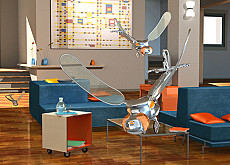Swiss robots brave Californian fires

Swiss robots have taken to the smoky skies of California and grabbed the attention of United States space agency Nasa and local firefighters.
Swiss engineers Jean-Christophe Zufferey and André Noth unveiled their creations to the US public last week at swissnex, the scientific arm of the Swiss consulate in San Francisco.
The two robotics experts brought several prototypes, including their solar glider which can fly for many hours non-stop and their miniature helicopter which can guide itself into a building.
At first sight the gadgets look like toys for spoilt children, but on closer inspection the robots could one day fly over Mars or assist the armed forces.
Thomas Zimmerman from the IBM research centre in California said last week he was impressed by the level of technology.
“Serious fires are currently ravaging California and I think this solar glider could be very useful for the firefighters in detecting the centre of the fires,” he said.
Nasa is working on a similar project but agency has yet to build one as light as that created by Noth, a researcher in autonomous systems at the Federal Institute of Technology in Zurich.
The 27-year-old is responsible for the “Sky Sailor” project, which aims to create a pilotless glider with a three-metre wingspan that can fly for 24 hours purely on solar power.
Noth is convinced that this promotional visit to California, the cradle of hi-tech companies, will result in collaborations with other researchers specialising in flying robots and possibly also attract the interests of commercial manufacturers.
“It’s true that our glider could give a vital helping hand to fire fighters by providing them with real-time information on the coordinates of the fires, but we can also envisage applications in space,” he said.
“The gliders, launched on Mars for example, could help map the Red Planet.”
Money makers
Chris Anderson, editor of influential US technology magazine Wired, was also impressed by the robots.
“They’re even smaller than I imagined – I can’t wait to see what they are capable of,” he said.
“I’m a huge fan of all miniature flying technologies and if André and Jean-Christophe can manufacture them for less than $1,000 [SFr1,166], I’m sure they’ll find an outlet in the games and leisure industry here in the US.”
Zufferey and Noth cast each other an amused glance. Sure, they’ve come to California to generate financing, but they’re not trying to make a quick franc.
Zufferey from the Federal Institute of Technology in Lausanne says he is considering various start-up ideas and is set to meet representatives from Nasa and the Pentagon, the headquarters of the US Defense Department.
But he says with a smile that he doesn’t want to say too much – “we wouldn’t want them to take our ideas!”
Competition
Zufferey says another benefit of the trip has been meeting researchers from Berkeley, the University of California, who like him have been working on applying robotics to aviation.
He has been developing for several years a miniature helicopter which can fly down the middle of the street avoiding obstacles and into a building on its own thanks to distance sensors.
“Our sensors are still too heavy,” he admitted. “But the day will come when we can make them lighter, and then the army and the police will definitely be interested.”
It is hard to say whether the Swiss or US researchers have made greater progress in the field of miniature robotics, but Zufferey says both groups complement and can learn from each other.
“At Berkeley they’ve gone further on the mechanical side – they can build robots the size of a fly that can bat their wings, something we can’t do in Switzerland,” he said.
“On the other hand, we are better on the computer side at controlling the motors. The two groups complement one another.”
swissinfo, Stephane Hiscock in San Francisco
Born in 1980, Noth graduated from the federal institute of technology in Lausanne.
Since 2006 he has worked at the Federal Institute of Technology in Zurich on his solar glider project, “Sky Sailor”.
Noth has published several articles on flying robots in research journals.
Zufferey gained a Masters in micro-engineering in 2001 from Carnegie Mellon University in Pittsburg and then joined the Federal Institute of Technology in Lausanne and has worked ever since in the artificial intelligence (AI) laboratory.
In 2006 he received the ABB (Asea Brown Boveri) award for best researcher.
Zufferey is passionate about aviation and last August organised an international symposium on flying robots

In compliance with the JTI standards
More: SWI swissinfo.ch certified by the Journalism Trust Initiative









You can find an overview of ongoing debates with our journalists here . Please join us!
If you want to start a conversation about a topic raised in this article or want to report factual errors, email us at english@swissinfo.ch.